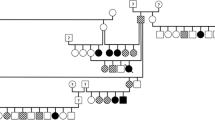Abstract
GATA4 is expressed early in the developing heart where it plays a key role in regulating the expression of genes encoding myocardial contractile proteins. Gene mutations in the human GATA4 have been implicated in various congenital heart defects (CHD), including atrial septal defect (ASD). Although ASD is the third most common CHD in humans, it is generally rare in dogs and cats. There is also no obvious predilection for ASD in dogs and cats, based on sex or breed. However, among dogs, the incidence rate of ASD is relatively high in Samoyeds and Doberman Pinschers, where its inheritance and genetic aetiology are not well understood. In this study, we identified and investigated the genetic aetiology of an ASD affected family in a pure breed dog population. Although the GATA4 gene was screened, we did not find any mutations that would result in the alteration of the coding sequence and hence, the predicted GATA4 structure and function. Although the aetiology of ASD is multifactorial, our findings indicate that GATA4 may not be responsible for the ASD in the dogs used in this study. However, this does not eliminate GATA4 as a candidate for ASD in other dog breeds.
Similar content being viewed by others
References
Allanson J. E. 1987 Noonan syndrome. J. Med. Genet. 24, 9–13.
Andelfinger G., Wright K. N., Lee H. S., Siemens L. M. and Benson D. W. 2003 Canine tricuspid valve malformation, a model of human Ebstein anomaly, maps to dog chromosome 9. J. Med. Genet. 40, 320–324.
Arceci R. J., King A. A., Simon M. C., Orkin S. H. and Wilson D. B. 1993 Mouse GATA-4, a retinoic acid-inducible GATA-binding transcription factor expressed in endodermally derived tissues and heart. Mol. Cell. Biol. 13, 2235–2246.
Basson C. T., Bachinsky D. R., Lin R. C., Bachinsky D. R., Weremowicz S., Vaglio A. et al. 1997 Mutations in human cause limb and cardiac malformation in Holt-Oram syndrome. Nature Genet. 15, 30–35.
Brickner M. E., Hillis D. and Lange R. A. 2000 Congenital heart disease in adult I. Medicine 342, 256–263.
Cirillo L. A., Lin F. R., Cuesta I., Friedman D., Jarnik M. and Zaret K. S. 2002 Opening of compacted chromatin by early developmental transcription factors HNF3 (FoxA) and GATA-4. Molecular Cell 9, 279–289.
Crispino J. D., Lodish M. B., Thurberg B. L., Litovsky S. H., Collins J. D., Molkentin J. D. and Orkin S. H. 2001 Proper coronary vascular development and heart morphogenesis depend on interaction of GATA-4 with FOG co-factors. Genes Dev. 15, 839–844.
Durocher D., Charron F., Warren R., Schwartz R. J. and Nemer M. 1997 The cardiac transcription factors Nkx2-5 and GATA-4 are mutual co-factors. EMBO J. 16, 5687–5696.
Garg V., Kathiriya I. S., Barnes R., Schluterman M. K., King I. N., Butler C. A. et al. 2003 GATA-4 mutations cause human congenital heart defects and reveal an interaction with TBX5. Nature 424, 443–447.
Huang W. Y., Cukerman E. and Liew C. C. 1995 Identification of a GATA motif in the cardiac alpha-myosin heavy-chain-encoding gene and isolation of a human GATA-4 cDNA. Gene 155, 219–223.
Hyun C., Kirk E., Fatklin D., Fenley M. and Harvey R. P. 2004 Human GATA4 mutation affecting cardiac atrial septal morphology and risk of ischaemic stroke In Proceedings of the 14th St.Vincents and Mater Health Sydney Research Symposium (ed. Shin J.), pp. 19–20 St. Vincents & Mater Health Sydney, Australia.
Hyun C. and Lavulo L. 2006 Congenital heart diseases in small animals. Genetic pathway and potential candidate genes. Vet. J. 171, 245–255.
Hyun C. and Park I. C. 2006 Congenital heart diseases in small animals II. Potential genetic aetiologies based on human genetic studies. Vet. J. 171, 256–262.
Kittleson M. K. and Kienle R. D. 1998 Small animal cardiovascular medicine. Mosby, St. Louis, USA.
Korenberg J., Bradley C. and Disteche C. 1992 Down syndrome, molecular mapping of congenital heart disease and duodenal stenosis. Am. J. Hum. Genet. 50, 294–302.
Laitinen M. P. E., Anttonen M., Ketola I., Wilson D. B., Ritvos O., Butzow R. and Heikinheimo M. 2000 Transcription factors GATA-4 and GATA-6 and a GATA family cofactor, FOG-2, are expressed in human ovary and sex cord-derived ovarian tumors. J. Clin. Endocrinol. Metab. 85, 3476–3483.
Molkentin J. D., Kalvakolanu D. V. and Markham B. E. 1994 Transcription factor GATA-4 regulates cardiac muscle-specific expression of the alpha-myosin heavy-chain gene. Mol. Cell. Biol. 14, 4947–4957.
Pehlivan T., Pober B. R., Brueckner M., Garrett S., Slaugh R., Van Rheeden R. et al. 1999 GATA4 haploinsufficiency in patients with interstitial deletion of chromosome region 8p23.1 and congenital heart disease. Am. J. Med. Genet. 83, 201–206.
Plageman Jr T. F. and Yutzey K. E. 2004 Differential expression and function of Tbx5 and Tbx20 in cardiac development. J. Biol. Chem. 279, 19026–19034.
Sambrook J., Fritsch E. F. and Maniatis T. 1989 Molecular Cloning: a laboratory manual, pp.34–42 Cold Spring Harbor Laboratory Press, New York.
Schott J. J., Benson D. W., Basson C. T., Pease W., Silberbach G. M., Moak J. P. et al. 1998 Congenital heart disease caused by mutations in the transcription factor NKX2-5. Science 281, 108–111.
Stennard F. A., Costa M. W., Elliott D. A., Rankin S., Haast S. J., Lai D. et al. 2003 Cardiac T-box factor Tbx20 directly interacts with Nkx2-5, GATA4, and GATA5 in regulation of gene expression in the developing heart. Dev. Biol. 262, 206–224.
Author information
Authors and Affiliations
Corresponding author
Rights and permissions
About this article
Cite this article
Lee, SA., Lee, SG., Moon, HS. et al. Isolation, characterization and genetic analysis of canine GATA4 gene in a family of Doberman Pinschers with an atrial septal defect. J Genet 86, 241–247 (2007). https://doi.org/10.1007/s12041-007-0031-x
Received:
Published:
Issue Date:
DOI: https://doi.org/10.1007/s12041-007-0031-x




